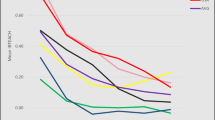Abstract
In this study, we explore the extent to which two instructional techniques promote critical discourse in an online class on educational standards and curriculum: instructor stance (challenging/nonchallenging) and topic level (higher order/lower order). Posts from 25 students, across four modules, were analyzed. These four modules constituted approximately one third of the course, and were selected because the professor was the sole facilitator for them. Results indicate that, regardless of topic level, a challenging stance by the professor had a positive effect on the percentage of student posts that referenced readings and theory. There was an interaction between level and stance on student use of reasoned argument. Lower order challenging forums were associated with a greater percentage of reasoned posts. This may be due to the abstractness of the professor's probes in higher order forums. Implications for future research include empirical investigations incorporating contextual variables and qualitative studies to ascertain how students engage with bulletin boards.
Similar content being viewed by others
References
Ahern, T.C., Peck, K., & Laycock, M. (1992). The effects of teacher discourse in computer-mediated communication.Journal of Educational Computing Research, 8, 291–309.
Allen, I.E., & Seaman, J. (2003).Sizing the opportunity: The quality and extent of online education in the United States, 2002–2003. Needham, MA: The Sloan Consortium.
Auster, C.J., & MacRone, M. (1994). The classroom as a negotiated social setting: An empirical study of the effects of faculty members' behavior on students' participation.Teaching Sociology, 22, 289–300.
Bloom, B.S. (Ed.) (1956).Taxonomy of educational objectives. Handbook 1: Cognitive domain. New York: Longman.
Bonk, C.J., & King, K.S. (Eds.). (1998).Electronic collaborators. Learner-centered technologies for literacy, apprenticeship, and discourse. Mahwah, NJ: Lawrence Erlbaum Associates.
Brookfield, S., & Preskill, S. (1999).Discussion as a way of teaching: Tools and techniques for demoncratic classrooms. San Francisco: Jossey-Bass Publishers.
Browne, M.N., & Freeman, K. (2000). Distinguishing features of critical thinking classrooms.Teaching in Higher Education, 5, 301–309.
Cho, K., & Jonassen, D. H. (2002). The effect of argumentation scaffolds on argumentation and problem solving.Educational Technology Research and Development, 50(3), 5–22.
Clasen, D.R., & Bonk, C. (1990).Teachers tackle thinking. Madison, Wisconsin Education Extension Programme.
Clark, R.E. (1994). Media will never influence learning.Educational Technology Research and Development, 42(2), 21–29.
DeBard, R., & Guidera, S. (2000). Adapting asynchronous communication to meet the seven principles of effective teaching.Journal of Educational Technology Systems, 28, 219–230.
Ellner, C.L., & Barnes, C.P. (1983).Studies of college teaching: Experimental results, theoretical interpretations, and new perspectives. Lexington, MA: D.C. Heath and Company.
Gallimore, R., & Tharp, R. (1990). Teaching mind in society: Teaching, schooling, and literate discourse. In L. Moll (Ed.),Vygotsky and education (pp. 175–205). New York, NY: Cambridge University Press.
Ge, X., & Land, S. M. (2003). Scaffolding students' problem-solving processes in an ill-structured task using question prompts and peer interactions.Educational Technology Research and Development, 51 (1), 21–38.
Gunawardena, C.N., Lowe, C.A., & Anderson, T. (1997). Analysis of a global online debate and the development of an interaction analysis model for examining social construction of knowdledge in computer conferencing.Journal of Educational Computing Research, 17, 397–431.
Hara, N., Bonk, C.J., & Angeli, C., (2000). Content analyses of on-line discussion in an applied educational psychology course.Instructional Science, 28, 115–152.
Hmelo, C.E., Guzdial, M., & Turns, J. (1998). Computer-support for collaborative learning: Learning to support student engagement.Journal of Interactive Learning Research, 9, 107–129.
Hewitt, J. (2003). How habitual online practices affect the development of asynchronous discussion threads.Journal of Educational Computing Research, 28, 31–45.
Jiang, M., & Meskill, C. (2000). Analyzing multiple dimensions of we-based courses: The development and piloting of a coding system.Journal of Educational Computing Research, 23, 451–469.
Kanuka, H., & Anderson, T. (1998). Online social interchange, discord, and knowledge construction.Journal of Distance Education, 13(1), 57–74.
Marttunen, M. (1998). Electronic mail as a forum for argumentative interaction in higher education studies.Journal of Computing Research, 18, 387–405.
McCoy, D. R., & Sorensen, C. K. (2003). Policy perspectives on selected virtual universities in the United States.Quarterly Review of Distance Education, 4, 89–107.
Nunn, C. E. (1996). Discussion in the college classroom: Triangulating observational and survey results.The Journal of Higher Education, 67, 243–266.
Pincas, A. (1998). Successful online course design: Virtual frameworks for discourse construction.Educational Technology & Society, 1, 14–25.
Pithers, R. T., & Soden, R. (2000). Critical thinking in education: A review.Educational Research, 42, 237–249.
Redfield, D. L. & Rousseau, E. W. (1981). A meta-analysis of experimental research on teacher questioning behavior.Review of Educational Research, 51(2), 237–245.
Scheurman, G. (1996). Professors' assumptions about students' critical thinking dispositions and epistemological beliefs.Journal of Excellence in College Teaching, 7(3), 43–69.
Scheurman, G., & Newmann, F. M. (1998). Authentic intellectual work in social studies: Putting performance before pedagogy.Social Education, 62(1), 23–25.
Schwier, R. A., & Balbar, S. (2002). The interplay of content and community in synchronous and asynchronous communication: Virtual communication in a graduate seminar.Canadian Journal of Learning and Technology, 28(2), 21–30.
Thomas, M. J. W. (2002). Learning within incoherent structures: The space of online discussion forums.Journal of Computer Assisted Learning, 18, 351–366.
Voss, J. F., & Means, M. L. (1991). Learning to reason via instruction in argumentation.Learning and Instruction, 1(4), 337–350.
Vygotsky, L. (1986).Thought and language. Cambridge, MA: The MIT Press.
Watts, M. M. (2003). Taking the distance out of education.New Directions for Teaching and Learning, 94, 97–103.
Author information
Authors and Affiliations
Rights and permissions
About this article
Cite this article
Gerber, S., Scott, L., Clements, D.H. et al. Instructor influence on reasoned argument in discussion boards. ETR&D 53, 25–39 (2005). https://doi.org/10.1007/BF02504864
Issue Date:
DOI: https://doi.org/10.1007/BF02504864




